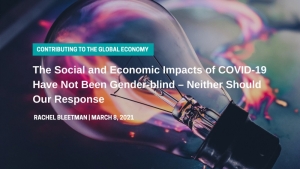عرض العناصر حسب علامة : البطالة
رسالة دكتوراه: الآثار والأبعاد الاقتصادية لفيروس كورونا (كوفيد 19) على المالية العامة في المملكة العربية السعودية وسبل علاجها
رسالة دكتوراه عن فيروس كورونا وهدف الدراسة التعرف على الآثار الاقتصادية الناتجة من فيروس كورونا على المالية العامة في المملكة العربية السعودية خلال تلك الفترة.
رسالة دكتوراه: أهم محددات الاقتصاد الكلي وآثارها على معدلات الفقر في مصر خلال الفترة من 2000 - 2020 باستخدام نموذج الإنحدار المتعدد
رسالة دكتوراه عن الاقتصاد الكلي وهدف الدراسة التعرف على متغيرات الإقتصاد الكلي المؤثرة على معدل الفقر في مصر.
رسالة دكتوراه: إدارة المخاطر بشركات التأمين على الممتلكات والمسئولية المسجلة بالبورصة المصرية باستخدام اختبارات الضغوط
رسالة دكتوراه عن إدارة المخاطر وهدف الدراسة وضع إطار لإدارة المخاطر بشركات التأمين على الممتلكات والمسئولية المسجلة بالبورصة المصرية باستخدام اختبارات الضغوط.
معلومات إضافية
- البلد مصر
- المدينة القاهرة
رسالة دكتوراه: تأثير سياسات التنمية الاقتصادية على القطاعات الاقتصادية المصرية "نموذج ARMA للتنبؤ 2021 - 2030"
رسالة دكتوراه عن التنمية الاقتصادية وهدف الدراسة تحليل تأثير سياسات التنمية الاقتصادية على مستوى القطاعات الاقتصادية المصرية باستخدام نموذج ARMA للتنبؤ خلال الفترة الزمنية 2021 - 2030.
معلومات إضافية
- البلد مصر
- المدينة القاهرة
رسالة ماجستير: أثر الاستثمار في المدن الصناعية في فلسطين على توفير فرص العمل
رسالة ماجستير عن الاستثمار وهدف الدراسة تحديد أثر الاستثمار في المدن الصناعية على توفير فرص العمل بالإضافة للتعرف على المعوقات التي تواجه المستثمرين في المدن الصناعية.
معلومات إضافية
- البلد فلسطين
رسالة ماجستير: المحاسبة عن المشروعات الصغيرة والمتوسطة في ضوء معايير الدولية كمدخل لدعم مفهوم العناقيد الصناعية
يهدف البحث إلى تحديد واقع إستخدام معايير المحاسبة الدولية فى المشروعات الصغيرة والمتوسطة الحجم فى محافظة دمياط بهدف الوصول لريادة الاعمال فى ضوء مفهوم العناقيد الصناعية
كورونا وعدم المساواة بين الجنسين
معلومات إضافية
-
المحتوى بالإنجليزية
The Social and Economic Impacts of COVID-19 Have Not Been Gender-blind – Neither Should Our Response
RACHEL BLEETMAN | MARCH 8, 2021
COVID-19 and gender inequality
The COVID-19 pandemic has affected every corner of the world and all aspects of society, and the impacts of it will be felt for decades to come. One particular troubling consequence has been its devastating impact on gender inequality. The evidence is clear – the gender inequality gap is widening despite decades of progress that sought to close it.
As a result of the pandemic, women’s employment is 19% more at risk compared to men’s (UN Women 2020) and women are more likely than men to take on unpaid care and domestic work in households. In addition, it is estimated that global domestic violence cases are up around 20% (BBC 2020). For women in more marginalised communities – such as women with disabilities, LBTQ women and women from ethnic minorities, compounding factors have led to even greater discrimination and inequality.
Addressing the crisis
To tackle gender inequality, governments around the world can employ a critically important public policy tool known as gender-responsive budgeting (GRB) when designing COVID-19 economic recovery packages. GRB is defined by UN Women as a ‘process of assessing the implications for women and men of any planned action, including legislation, policies and programmes, in all areas and at all levels.’ It is importantly, not a process of allocating resources to men or women separately nor is it necessarily about allocating more resources than originally planned. Rather, it is a technical process of assessing existing budget policies to better evaluate their impacts on gender equality as well as being a high-level commitment to combat gender inequality. It is also not a new concept – it has been implemented in some form in over 80 countries (Stotsky 2020) since it was first developed in the 1980s.
To be most effective, gender-responsive budgeting techniques should be found throughout the policy and budget cycle. From the initial policy design, through to design and implementation and of course, in the auditing and evaluation stage. By adding a gendered perspective to each part of the cycle, policymakers and public finance professionals can ensure that they adequately account for the differing needs of men and women in a more holistic way. To promote the use of GRB in the COVID-19 response and to enable public sector finance professionals to employ the tool effectively, ACCA has developed a set of tools and resources to help the profession learn more about GRB and implement it wherever they are based.
An example of how to use gender-responsive budgeting
The UK’s Office of National Statistics releases data on unemployment disaggregated by both sex and sector each quarter. For August to October 2020, the unemployment figures were as follows:
74,000 people were classified as being unemployed in the construction sector. When filtered by sex, it shows that men accounted for 86% of that figure while 14% were women.
So, when designing a policy response aimed at tackling unemployment in the construction sector, it is critical that policymakers consider the gendered impact of what a construction job package might look like. It is clear from the sex-disaggregated data that the majority of end-users of this policy decision and budget allocation will be men. Therefore, subsequent or supplementary measures should be considered to ensure that female-dominated sectors are also prioritised in job retention or reskilling schemes to avoid women being overrepresented in the unemployment figures.
Additionally, exploring qualitative data can help better understand why women are so underrepresented in this sector – what barriers exist that have clearly prevented women from entering the construction sector? And for men, more data could probe thinking around, for example, the impacts of unemployment on mental health. Policymakers could also consider what policies could be used to equip those made unemployed with skills beyond construction. This initial process will encourage a more holistic approach to this particular package to fully understand its broader objectives outside of simply saving jobs. By assessing the impact of the policy on both men and women, policymakers can ensure that this policy response does not unintentionally exacerbate or perpetuate gender inequality.
Having explored the objectives, the next stage involves designing the policy and allocating the adequate resources to ensuring the policy will achieve its intended outcome. To do so, a number of useful techniques can be employed, for example –an equality impact assessment can be carried out to assess the expected impact on both women and men. The policy should also be subject to parliament scrutiny with a gendered lens. It is important to ensure that the way the policy is designed and measured will achieve the ultimate objective. For example, considering whether to use performance-based budgeting to measure outcomes or whether a zero-based budgeting approach would work better if this is a new policy objective.
At the implementation stage, considerations include whether line ministries have the training and capacity to implement the policy, and if sufficient resources have been allocated to achieve the objectives. Importantly, public finance professionals can use an expenditure tracking system to ensure actual spending meets planned spending – this will also improve the audit trail for the final evaluation stage. Finally, the finance professional can help ensure that the policy objective was met – this is where the vital role of auditors comes into play, to assess:
Was the intended objective met?
How mainstreamed was gender throughout the process?
And critically, what should be improved for the next cycle?
Supreme Audit Institutions have a critical role to play in ensuring that governments achieve both the objectives they lay out in budget statements, but also in ensuring governments meet their commitments to achieving the Sustainable Development Goals (SDGs)– in this case, SDG 5 on gender equality.
The central role of the finance profession
As the resources on ACCA’s website outlines, GRB can be implemented in any jurisdiction if certain conditions are in place. The public finance profession can play a key role, wherever they are in the world, to make GRB a reality and to shed a renewed light on COVID-19 and its impact on gender inequality. From ensuring data is disaggregated by sex, using that data to inform policymaking, designing budgets that can measure defined objectives and measuring progress made on achieving those objectives - the public finance profession is at the heart of GRB.
To learn more about what GRB is, where it can be found, how to implement it and what the profession can do to raise awareness of this policy tool, go to ACCA’s website to see our newly published resources and register here for our CPD webinar on GRB and the COVID-19 economic recovery.







